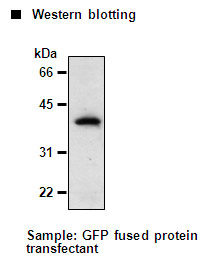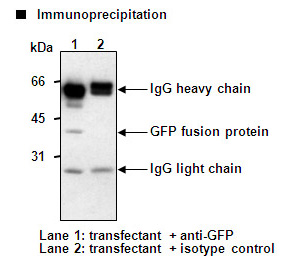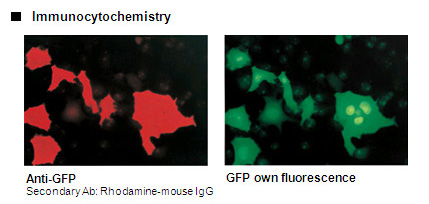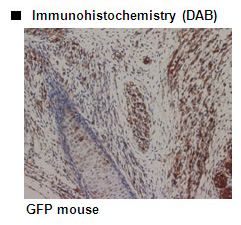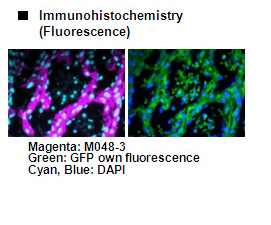| Citations |
Western Blotting - Abe Y et al. Mammalian Gup1, a homolog of Saccharomyces cerevisiae glycerol uptake/transporter 1, acts as a negative regulator for N-terminal palmitoylation of Sonic hedgehog. FEBS J. 275, 318-31 (2008)(PMID:18081866)
- Komuro A et al. Diffuse-type gastric carcinoma: progression, angiogenesis, and transforming growth factor beta signaling. J Natl Cancer Inst. 101, 592-604 (2009)(PMID:19351925)
- Takahata M et al. Ro52 functionally interacts with IgG1 and regulates its quality control via the ERAD system. Mol Immunol. 45, 2045-54 (2008)(PMID:18022694)
- Masuda M et al. The tumor suppressor protein TSLC1 is involved in cell-cell adhesion. J Biol Chem. 277, 31014-9 (2002)(PMID:12050160)
- Nakamichi I et al. Formation of Mallory body-like inclusions and cell death induced by deregulated expression of keratin 18. Mol Biol Cell 13, 3441-51 (2002)(PMID:12388748)
- Song Z et al. Direct interaction between survivin and Smac/DIABLO is essential for the anti-apoptotic activity of survivin during taxol-induced apoptosis. J Biol Chem. 278, 23130-40 (2003)(PMID:12660240)
- de Graaf K et al. Characterization of cyclin L2, a novel cyclin with an arginine/serine-rich domain: phosphorylation by DYRK1A and colocalization with splicing factors. J Biol Chem. 279, 4612-24 (2004)(PMID:14623875)
- Iwai S et al. A novel actin-bundling kinesin-related protein from Dictyostelium discoideum. J Biol Chem. 279, 4696-704 (2004)(PMID:14623897)
- Lozupone F et al. Identification and relevance of the CD95-binding domain in the N-terminal region of ezrin. J Biol Chem. 279, 9199-207 (2004)(PMID:14676203)
- Pottekat A, Menon AK. Subcellular localization and targeting of N-acetylglucosaminyl phosphatidylinositol de-N-acetylase, the second enzyme in the glycosylphosphatidylinositol biosynthetic pathway. J Biol Chem. 279, 15743-51 (2004)(PMID:14742432)
- Hisatsune C et al. Regulation of TRPC6 channel activity by tyrosine phosphorylation. J Biol Chem. 279, 18887-94 (2004)(PMID:14761972)
- Kontrogianni-Konstantopoulos A et al. Obscurin regulates the organization of myosin into A bands. Am J Physiol Cell Physiol. 287, C209-17 (2004)(PMID:15013951)
- Hanamoto T et al. Identification of protein kinase A catalytic subunit beta as a novel binding partner of p73 and regulation of p73 function. J Biol Chem. 280, 16665-75 (2005)(PMID:15723830)
- Reversi A et al. Effects of cholesterol manipulation on the signaling of the human oxytocin receptor. Am J Physiol Regul Integr Comp Physiol. 291, R861-9 (2006)(PMID:16966388)
- Takeda K et al. Apoptosis signal-regulating kinase (ASK) 2 functions as a mitogen-activated protein kinase kinase kinase in a heteromeric complex with ASK1. J Biol Chem. 282, 7522-31 (2007)(PMID:17210579)
- Lebel-Haziv Y et al. Breast cancer: coordinated regulation of CCL2 secretion by intracellular glycosaminoglycans and chemokine motifs. Neoplasia 16, 723-40 (2014)(PMID:25246273)
- Zhang B et al. GSK3β-Dzip1-Rab8 cascade regulates ciliogenesis after mitosis. PLoS Biol. 13, e1002129 (2015)(PMID:25860027)
- Li Z et al. Destabilization of linker histone H1.2 is essential for ATM activation and DNA damage repair. Cell Res. 28, 756-770 (2018)(PMID:29844578)
- Tsukune N et al. Forced expression of mouse progerin attenuates the osteoblast differentiation interrupting β-catenin signal pathway in vitro. Cell Tissue Res. 375, 655-664 (2019)(PMID:30284086)
- Wang T et al. Stabilization of PTGES by deubiquitinase USP9X promotes metastatic features of lung cancer via PGE2 signaling. Am J Cancer Res.9, 1145-1160 (2019)(PMID:31285948)
- Kawamura Y et al. Extracellular vesicles mediate the horizontal transfer of an active LINE-1 retrotransposon. J Extracell Vesicles. 8, 1643214 (2019)(PMID:31448067)
- Naoto Matsumoto N et al. PP1C and PP2A are p70S6K Phosphatases Whose Inhibition Ameliorates HLD12-Associated Inhibition of Oligodendroglial Cell Morphological Differentiation. Biomedicines. 8, 89 (2020)(PMID:32316234)
- Koshizuka T, Inoue N. Activation of c-Jun by human cytomegalovirus UL42 through JNK activation. PLoS One. 15, e0232635 (2020)(PMID:32369499)
- Kido K et al. AirID, a novel proximity biotinylation enzyme, for analysis of protein-protein interactions. Elife. 9, e54983 (2020)(PMID:32391793)
- Chowdhury MIH et al. Prickle2 and Igsf9b Coordinately Regulate the Cytoarchitecture of the Axon Initial Segment. Cell Struct Funct. 45, 143-154 (2020)(PMID:32641624)
Immunoprecipitation - Banerjee S et al. A coordinated local translational control point at the synapse involving relief from silencing and MOV10 degradation. Neuron. 64, 871-84 (2009)(PMID:20064393)
- Asada N, Sanada K. LKB1-mediated spatial control of GSK3beta and adenomatous polyposis coli contributes to centrosomal forward movement and neuronal migration in the developing neocortex. J Neurosci. 30, 8852-65 (2010)(PMID:20592207)
- Kiriyama M et al. Interaction of FLASH with arsenite resistance protein 2 is involved in cell cycle progression at S phase. Mol Cell Biol. 29, 4729-41 (2009)(PMID:19546234)
- Kojima K et al. Associations between PIWI proteins and TDRD1/MTR-1 are critical for integrated subcellular localization in murine male germ cells. Genes Cells 14, 1155-65 (2009)(PMID:19735482)
- Federici C et al. Pleiotropic function of ezrin in human metastatic melanomas. Int J Cancer. 124, 2804-12 (2009)(PMID:19235924)
- Ozoe F et al. The 14-3-3 proteins Rad24 and Rad25 negatively regulate Byr2 by affecting its localization in Schizosaccharomyces pombe. Mol Cell Biol. 22, 7105-19 (2002)(PMID:12242289)
- de Graaf K et al. Characterization of cyclin L2, a novel cyclin with an arginine/serine-rich domain: phosphorylation by DYRK1A and colocalization with splicing factors. J Biol Chem. 279, 4612-24 (2004)(PMID:14623875)
- Lozupone F et al. Identification and relevance of the CD95-binding domain in the N-terminal region of ezrin. J Biol Chem. 279, 9199-207 (2004)(PMID:14676203)
- Lebel-Haziv Y et al. Breast cancer: coordinated regulation of CCL2 secretion by intracellular glycosaminoglycans and chemokine motifs. Neoplasia 16, 723-40 (2014)(PMID:25246273)
- Zhang B et al. GSK3β-Dzip1-Rab8 cascade regulates ciliogenesis after mitosis. PLoS Biol. 13, e1002129 (2015)(PMID:25860027)
- Watanabe N et al. Dystonia-4 (DYT4)-associated TUBB4A mutants exhibit disorganized microtubule networks and inhibit neuronal process growth. Biochem Biophys Res Commun. 495, 346-352 (2018)(PMID:29127012)
- Li Z et al. Destabilization of linker histone H1.2 is essential for ATM activation and DNA damage repair. Cell Res. 28, 756-770 (2018)(PMID:29844578)
Immunocytochemistry - Banerjee S et al. A coordinated local translational control point at the synapse involving relief from silencing and MOV10 degradation. Neuron. 64, 871-84 (2009)(PMID:20064393)
- Asano Y et al. DRR1 is expressed in the developing nervous system and downregulated during neuroblastoma carcinogenesis. Biochem Biophys Res Commun. 394, 829-35 (2010)(PMID:20298674)
- Ko HS et al. Role of ubiquilin associated with protein-disulfide isomerase in the endoplasmic reticulum in stress-induced apoptotic cell death. J Biol Chem. 277, 35386-92 (2002)(PMID:12095988)
- Liu Y et al. TRIM25 Promotes the Cell Survival and Growth of Hepatocellular Carcinoma Through Targeting Keap1-Nrf2 Pathway. Nat Commun. 11, 348 (2020)(PMID:31953436)
- Koshizuka T, Inoue N. Activation of c-Jun by human cytomegalovirus UL42 through JNK activation. PLoS One. 15, e0232635 (2020)(PMID:32369499)
Immunohistochemistry - Broday L et al. The LIM domain protein UNC-95 is required for the assembly of muscle attachment structures and is regulated by the RING finger protein RNF-5 in C. elegans. J Cell Biol. 165, 857-67 (2004)(PMID:15210732)
- Sugawara T et al. Type 1 inositol trisphosphate receptor regulates cerebellar circuits by maintaining the spine morphology of purkinje cells in adult mice. J Neurosci. 33, 12186-96 (2013)(PMID:23884927)
- Katsushima K et al. Targeting the Notch-regulated non-coding RNA TUG1 for glioma treatment. Nat Commun. 7, 13616 (2016)(PMID:27922002)
- Shainer I et al. Novel hypophysiotropic AgRP2 neurons and pineal cells revealed by BAC transgenesis in zebrafish. Sci Rep. 7, 44777 (2017)(PMID:28317906)
Immunofluorescence - Sun J et al. Histone H1-mediated epigenetic regulation controls germline stem cell self-renewal by modulating H4K16 acetylation. Nat Commun. 6, 8856 (2015)(PMID:26581759)
- Shimizu T et al. The C. elegans BRCA2-ALP/Enigma Complex Regulates Axon Regeneration via a Rho GTPase-ROCK-MLC Phosphorylation Pathway. Cell Rep. 24, 1880-1889 (2018)(PMID:30110643)
- Iwata M et al. Regulatory mechanisms for the axonal localization of tau protein in neurons. Mol Biol Cell.30, 2441-2457 (2019)(PMID:31364926)
|












 Citations
Citations Data Sheet
Data Sheet
